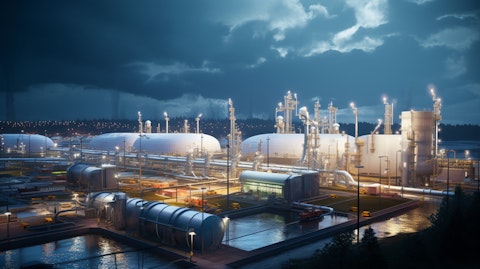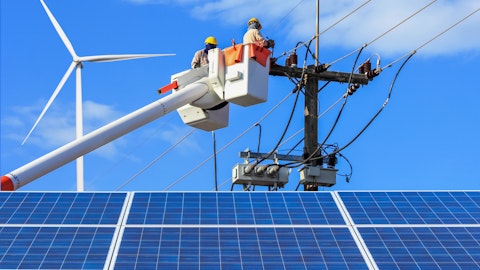Spire Inc. (NYSE:SR) Q4 2023 Earnings Call Transcript November 16, 2023
Spire Inc. misses on earnings expectations. Reported EPS is $-0.78 EPS, expectations were $-0.66.
Operator: Good day and welcome to the Spire Year-End Earnings Conference Call. All participants will be in listen-only mode. [Operator Instructions] After today’s presentation, there will be an opportunity to ask questions. [Operator Instructions] Please note this event is being recorded. I would now like to turn the conference over to Scott Dudley with Spire Investor Relations. Please go ahead.
Scott Dudley: Good morning, and welcome to Spire’s fiscal 2023 year-end earnings call. We issued an earnings release this morning, and you may access it on our website at spireenergy.com under Newsroom. There is a slide presentation that accompanies our webcast, and you may download it from either the webcast site or from our website under Investors and then Events and Presentations. Before we begin, let me cover our safe harbor statement and the use of non-GAAP earnings measures. Today’s call, including responses to questions, may contain forward-looking statements within the meaning of the Private Securities Litigation Reform Act of 1995. Though our forward-looking statements are based on reasonable assumptions, there are various uncertainties and risk factors that may cause future performance or results to be different than those anticipated.
These risks and uncertainties are outlined in our quarterly annual filings with the SEC. In our comments, we will be discussing net economic earnings and contribution margin, which are both non-GAAP measures used by management, evaluating our performance and results of operations. Explanations and reconciliations of these measures to their GAAP counterparts are contained in both our news release and the slide presentation. Presenting on the call today is Steven Lindsey, President and CEO; Steven Rasche, Executive Vice President and CFO. Also in the room today is Adam Woodard, Vice President, Treasurer and CFO of our gas utilities. I also want to formally introduce Megan McPhail, recently joined Spire as Managing Director of Investor Relations.
Megan brings 15 years of experience in the utility industry, including five years in Investor Relations. He is taking the reins as I will be retiring on March 1 of next year. With that, I will turn the call over to Steve Lindsey.
Steven Lindsey: Thank you, Scott, and good morning, everyone. I’m pleased to have this opportunity as CEO to update you on our performance for last year and outline our priorities, plans and outlook this year and beyond. I want to start by acknowledging the vision and leadership of Suzanne Sitherwood, our CEO over the last dozen years, who has driven the successful execution of our strategic priorities to grow and transform our company. Under her stewardship, we attained the scale and foundation have positioned us to organically grow our gas utilities, expand our gas marketing operations and strategically invest in midstream. Today Spire is a financially strong and expanding natural gas company that is well positioned as a leader in the industry.
I’m honored to build on this strong foundation and lead Spire into the future. In doing so, I want to emphasize that our strategy will not change. We remain committed to the same priorities, growing our businesses, investing in infrastructure and driving continuous improvement and our focus on strong operations and successful execution of our plans remains. While FY ‘23 presented challenges in headwinds, including regulatory outcomes, weather, inflation our commodity costs and rising interest rates, we were able to meet our capital plan focused on our gas utilities and marketing was well positioned to take advantage of market opportunities. We also advance our midstream segment, the announced acquisition of MoGas and the purchase of Salt Plains storage facility.
We’re positioned for success in FY ‘24 and beyond as we continue delivering on our growth strategy. We have a robust 10-year CapEx plan centered on pipeline upgrades and new business for our gas utilities. We remain squarely focused the basics of strong execution, which includes driving greater efficiency through streamlining systems and processes, maintaining an unwavering commitment to operational excellence. Same time, we’ll work to further advance our marketing and midstream businesses, building on recent expansion and growth. I’m confident in our ability to deliver value over the long term for customers, communities, employees and shareholders. We’ll achieve this through our strong focus on providing safe, reliable, as-effective energy with excellent service while advancing our commitment to become carbon neutral company by mid-century.
For FY ‘23, we reported net economic earnings of $4.05 per share, reflecting higher earnings in gas marketing in midstream, offset by lower earnings from our gas utilities. Steve will discuss our financial results in more detail in a moment. In FY ’24, today, we are launching earnings guidance of $4.25 to $4.45 per share and reiterating our long-term annual earnings growth target of 5% to 7%. [Indiscernible] for that growth is the midpoint of our FY ‘24 guidance range of $4.35 per share. You know the long-term driver of our earnings growth is capital investment in our gas utilities. For FY ’23, our capital investment totaled $663 million, with nearly 90% invested in our gas utilities. Of that amount, we invested $290 million in upgrades of our pipeline infrastructure, an additional $110 million to connect more homes and businesses to stay reliable and affordable natural gas service.
The midstream segment, CapEx totaled $73 million, largely for the expansion of Spire Storage West. I would note that our cash spend in midstream came in below our forecast for the year due to timing. However, the project remains on schedule and on budget. Looking to FY ‘24, we expect to increase our utility capital investment to $660 million, reflecting increases in infrastructure and new business as well as further deployment of advanced meters. We’ll also be making an initial investment in an RNG project, Spire Missouri is developing in partnership with Kansas City Water Department. And 70% of our gas utility spend this year, we invested system reliability and safety and another 16% was dedicated to customer growth. Midstream CapEx is expected to be $105 million, reflecting the timing and construction equipment purchases for our storage expansion project that I just mentioned.
Recognizing our performance in 2023 as well as confidence in our long-term growth plans, our Board of Directors recently increased Spire’s common dividend by 4.9% with an annualized rate of $3.02 per share. It was the 21st consecutive year of dividend increases, which we have continuously paid since 1946. With that, I’ll turn it over to Steve Rasche for a financial review and update on our guidance and outlook. Steve?

Steven Rasche: Thanks, Steve, and good morning, everyone. Let’s start with a brief review of results, and then I’ll share our expectations as we look through 2024 and beyond. For fiscal year ended September 30, 2023, we reported net economic earnings of $228 million, 5.5% ahead of last year. On a per share basis, our earnings of $4.05 were $0.19 ahead of last year. These full-year results incorporate our fourth quarter loss of $38 million or $0.78 per share, reflecting the seasonality of our business. Full analysis of our quarter is included in the appendix to this presentation, and I will focus on my remarks today on the full fiscal year. Looking at our business segments. Our guest utilities are just over $200 million, down 1% from last year as new customer rates in both Missouri and Alabama were more than offset by higher interest expense and the impacts of warm weather.
As marketing was well positioned to take advantage of commodity price volatility last winter and posted earnings of just under $48 million, an increase of more than 75%, compared to last year. Midstream delivered earnings of $14 million, up $3 million from last year, reflecting our growing scale and optimization. And finally, higher interest expense and corporate costs. Looking a bit deeper into our results, starting with revenues and margins here on slide seven. Revenues were up 21% this year with our gas utility revenues up $511 million, reflecting higher gas costs, including both the higher commodity costs from last winter, as well as deferred gas costs than the previous year. As a reminder, Gas costs are passed through on our customer build and netting out those costs, the gas utility contribution margin grew by 8%, reflecting principally new rates in Missouri and Alabama, including ISRS filings in Missouri.
Marketing contribution margin was also higher as they created significant value from the transportation and storage positions as a result of favorable market conditions. Midstream margin was up $13 million, reflecting our growing operations and optimization of injection and withdrawal commitments. This increase also reflects the addition of Salt Plains in our fiscal third quarter. This storage business is performing well against our expectation. And while its revenues and margins are included here in this analysis based on GAAP financials, its earnings are excluded from the consolidated net economic earnings in fiscal year ’23. As I touch on shortly, Salt Plains will be fully included in our net economic earnings in fiscal ’24 and beyond. Moving on a couple of other key variances on the next slide and focusing on the net variance column.
Gas Utility operations and maintenance expenses reflect higher bad debts and the $24 million of Missouri overhead costs that were expensed in ’23, but deferred in ’22. The remaining run rate expenses were up just over $10 million or 2.5% as our cost controls helped offset higher non-payroll expenses. O&M costs for our marketing and midstream segments reflect growth in those businesses. Corporate costs were higher this year, primarily due to one-time consulting and professional services fees not anticipated to recur in 2024. Interest expense for the year was up nearly $66 million, driven equally by two factors: First, long-term debt balances that were higher by approximately $475 million net of refinancings. Second, higher short-term interest rates, up roughly 390 basis points over last year.
We continue to make progress in collecting our deferred gas cost balances and expect to substantially recover them by the end of the heating season. Other income reflects the investment income from our benefit plans, plus roughly $14 million in higher Missouri carrying cost credits. Now turning to our outlook. We anticipate our net economic earnings per share for fiscal year ’24 to be between $4.25 and $4.45 per share, as Steve mentioned. We are also reconfirming our long-term earnings per share growth target beyond 2024 of 5% to 7% using the midpoint of our fiscal year ‘24 range of $4.35 as base. As a reminder, our long-term target is calibrated around safety, reliability and affordability with the cost of capital recovery mechanisms. As Steve mentioned earlier, we’ve updated and extended our capital spend plan for fiscal year [‘33] (ph) and raised the target to $7.2 billion.
Turning to slide 10. Here are our business unit earnings ranges for fiscal year ’24. Let me hit on a few points. We anticipate our gas utilities to earn between $230 million and $240 million next year, reflecting the combined benefits of a full-year of new Missouri rates as well as ISRS filings, new Alabama rates and lower interest expense and cost management. Gas marketing is anticipated to earn $19 million to $23 million, a slight increase in our baseline expectations driven by customer growth. [Technical Difficulty] expects to earn between $21 million and $27 million, reflecting the addition of Salt Plains and the expected closing of the MoGas acquisition. In addition, see the earnings pull-through in the back half of fiscal year ‘24 as we begin operating the first tranche of new storage capacity at Spire Storage West.
Corporate and Other, principally interest cost is anticipated to be in the range of negative $18 million to negative $22 million, down significantly from last year based upon lower corporate costs and lower interest costs, including the impacts of interest rate hedging. Speaking of interest and financing, we’ve also updated our three-year financing plan as outlined here on slide 11. I am pleased to say that we have locked in approximately 80% of our equity needs for fiscal year ‘24. This includes the forward sales agreement from earlier this year of roughly $113 million, that’s expected to settle by the end of the calendar year. It also reflects the $175 million conversion of equity units on March 1. We’ll look to our ATM program for the remaining equities in fiscal year ’24, and we expect very modest equity needs in 2025 and 2026.
Turning to debt financing. We expect to refinance $150 million debt maturity at Spire Inc., as well as complete the remarketing of the debt component of our equity units. In addition, we expect to issue an incremental $50 million to $100 million of new long-term debt support the MoGas acquisition. We have no planned issuance beyond the refinancing of maturing debt in fiscal years ‘25 and ‘26 and remain well positioned relative to future interest rates. We continue to target FFO to debt at 15% to 16% on a consolidated basis and expect to be in this range in 2025. In summary, we are executing in line with our plans as we turn the page to fiscal year ’24. We are well positioned to deliver both operationally and financially. With that, let me turn it back over to you, Steve.
Steven Lindsey: Thanks, Steve. In fiscal ’23, we delivered solid financial and operating performance, including strong results for Spire Market. We’re going to execute on our capital investment plan, supporting the growth of our gas utilities and the expansion of Spire Storage. Moving on this momentum, we are squarely focused on executing to achieve our performance targets for FY ’24 and beyond. We look forward to updating you on our performance and progress throughout the year. Thank you for joining us today, and now we’re ready to take questions.
Operator: Thank you. We will now begin the question-and-answer session. [Operator Instructions] Our first question comes from Richard Sunderland with JPMorgan. Please go ahead.
See also 15 Most Advanced Countries in Engineering and 50 Most Populated Countries in 2030.
Q&A Session
Follow Spire Inc (NYSE:SR)
Follow Spire Inc (NYSE:SR)
Richard Sunderland: Hi, good morning. Am I coming through clearly?
Steven Lindsey: They are. Good morning, Richard.
Richard Sunderland: Great. Thank you. Can you unpack 2023 relative to the 3Q outlook particularly what landed in the utility results versus plan? I’m curious if any of this is work to de-risk 2024 that’s showing up as a expenses in ‘23?
Steven Rasche: Yes, Rich, this is Steve. Let me take a shot and I’m sure that Adam or Steve want to weigh in. Yes, if you look at our Q4 against our guidance. Interest expense came in a little bit hotter as you might recall. Short-term rates went up a little bit beyond what the market, including your firm had predicted. And so we had to offset that. And then it really was corporate cost. A lot of those are one-off professional fees and things that we don’t expect to recur, which is why you see the corporate costs coming back in line next year. Those were the big drivers. Everybody else came in reasonably in line with the plan that we would have expected.
Richard Sunderland: Got it. Understood. And then you touched on this a little bit to the previous question, but what are you assuming in 2024 cost management curious where those efforts stand in your overall line of sight to 2024 expenses, I guess, mostly the utilities that you talked about the corporate one-offs?
Steven Rasche: Yes. Let me start on the cost management, which you saw in the back half of this last fiscal year, and it shouldn’t be lost on anyone that we started the year as many folks did pretty hot in the run rate of expenses, and we ended up bringing those back down to below the 4% that we had guided after you pull out bad debt. So that the efforts that we continue to have in place, which start with how we operate efficiently and involving technology and innovation really are continuing into next year. We’ve got a number of initiatives that get us off on the right foot starting out. If you kind of run down the big movers, bad debt was one that traded against us last year. That was more reflective of the higher commodity costs last year, which is fleshing through.
We have a really solid collection program. I don’t suspect given where commodity costs are now, that we’ll see that as an adverse move. It probably moves back in the right direction. We continue to manage not only our — the cost that we can control in a big way, which would be the cost that we incur operating the businesses, but also our third-party cost. And you know that there were a lot of headwinds in third-party costs this year. And it’s not just us. You’ve heard it from the industry and the cost of locates some professional fees. And we see those moderating as we’ve seen overall inflation rates coming back down to a more reasonable level. So those would be some of the key items that we’re working on.
Steven Lindsey: And thanks, this is Steve Lindsey. And I think just to follow up on what we’re really looking to do going forward, and it started this year, like Steve mentioned, is really drive value throughout the utilities we are on common platforms now, which makes a lot of difference when you think about it from a logistics perspective, whether it’s around managing the people, managing the materials from a supply chain perspective of the fleet. So I think we’re set up well to do that, as well as really starting to reap the benefits of the capital investments that we’ve been making on infrastructure. If you think about one of the metrics that we follow very closely our leach for thousands system is down over 60% over the last five years. Those are O&M costs that in the future will not occur. So I think all those things together really strong foundation for managing, you know, our expenses not only in the near-term, but really more for the long-term.
Steven Rasche: Yes. And then, Rich, you had asked a question on the other line which was coming down pretty dramatically. The biggest mover there is going to be interest rates. We’ve — our level of borrowing is down and we’re managing interest rates. As you know, we are fairly active in interest rate hedging, which provides befits going forward. So we actually see interest cost at the Holdco level, which is what homes up in corporate and other down from the run rate that we’ve seen in ‘23. And then those one-off costs aren’t going to recur. So our cost control isn’t just at the operating businesses, , it’s really how we manage at the shared services level, and we’re seeing some great benefits there.
Richard Sunderland: Great. Thank you for all the color there. I’ll pass it along.
Operator: Our next question comes from Gabe Moreen with Mizuho. Please go ahead.
Gabe Moreen: Good morning, everyone. Maybe if I can just keep on gas cost/interest expense outlook. Can you just talk about maybe starting with the latter, the interest expense hedges and the lack of sensitivity to short-term rates in ’24. Were those hedges you had entered into a while ago? Are those relatively recent? And then also on the gas cost, maybe you can just talk about I guess, is this just a question of the forward curve, you’re making your own assumptions on gas costs. Just curious about that.



